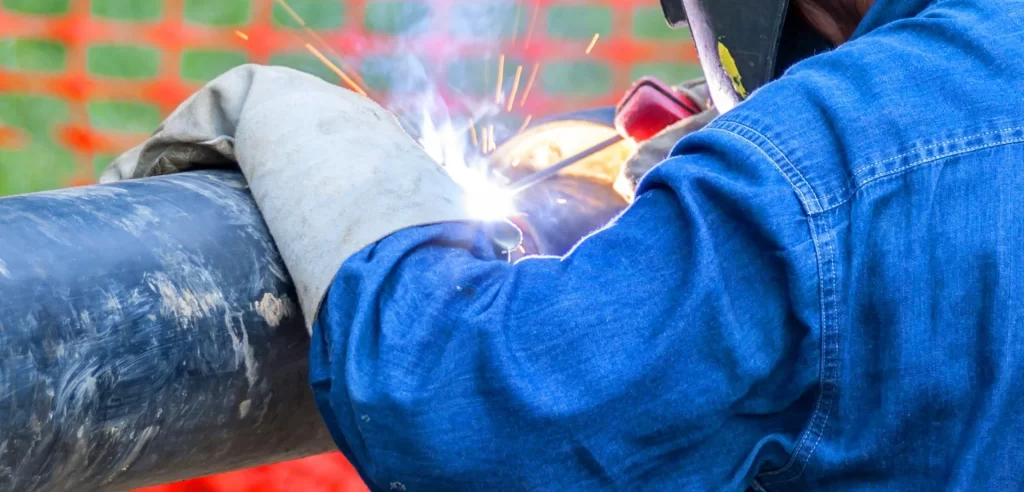Boost Welding Efficiency: Invest in Reputable Inspection Service
Boost Welding Efficiency: Invest in Reputable Inspection Service
Blog Article
Unveiling the Diverse Array of Welding Services and Their Benefits
As sectors continue to progress and require accuracy in their manufacturing processes, the significance of welding solutions has ended up being progressively obvious. From the convenience of arc welding to the effectiveness of MIG welding, and the intricate job completed via TIG welding to the accuracy of laser welding, the variety of welding methods readily available is huge.
Types of Welding Solutions
One usual kind is MIG welding, also understood as Gas Steel Arc Welding (GMAW), which uses a cable electrode to join steels with each other. An additional commonly utilized technique is TIG welding, or Gas Tungsten Arc Welding (GTAW), which uses a non-consumable tungsten electrode to create a tidy and accurate weld.
Furthermore, there is Stick welding, or Shielded Steel Arc Welding (SMAW), which is recognized for its simplicity and efficiency, specifically in exterior or windy conditions. There is Flux-Cored Arc Welding (FCAW), which is a functional process appropriate for thick products and can be used in both semi-automatic and automatic applications.
Benefits of Arc Welding
Arc welding offers a wide range of advantages that cater to numerous commercial demands and needs. Furthermore, arc welding is known for its high welding rates, which can significantly raise performance in producing processes.
An additional secret advantage of arc welding is its ability to develop solid and resilient welds. Arc welding also generates precise and tidy welds, decreasing the demand for added ending up work.
Advantages of MIG Welding
With an emphasis on efficiency and resilience in welding procedures, MIG welding offers an unique set of advantages that match the flexibility and strength discovered in arc welding. MIG welding, or Gas Metal Arc Welding (GMAW), is known for its rate and simplicity of use.
Furthermore, MIG welding generates clean welds with marginal splatter, lowering the requirement for comprehensive cleaning after the welding procedure. The adaptability of MIG welding permits for welding a variety of materials, including light weight aluminum, stainless-steel, and mild steel. This versatility makes MIG welding ideal for numerous sectors, from automobile to construction.
Moreover, MIG welding is recognized for its high deposition prices, implying even more material can be transferred in a much shorter amount of time contrasted to other welding procedures. This leads to boosted efficiency and cost-effectiveness for jobs that call for additional resources huge quantities of welds. Overall, the advantages of MIG welding make it a beneficial strategy for attaining durable and effective welds across different applications.

Discovering TIG Welding Conveniences
TIG welding, likewise known as Gas Tungsten Arc Welding (GTAW), uses a distinctive collection of benefits that cater to accuracy and control in welding applications. One of the key benefits of TIG welding is its ability to create top quality, clean welds without the need for filler material.
Moreover, TIG welding can be used on a vast variety of metals, consisting of stainless steel, titanium, aluminum, and copper, making it a functional selection for numerous welding jobs. The process additionally enables for welding in numerous settings, providing versatility in challenging welding circumstances.
Advantages of Laser Welding

An additional advantage of laser welding is its adaptability in working with a large range of materials, including steels, plastics, and also different products. This adaptability makes laser welding appropriate for varied sectors such as automotive, aerospace, electronic devices, and medical devices. The non-contact nature of laser welding additionally reduces contamination, making it a eco friendly and clean welding technique.
Additionally, laser welding allows intricate and elaborate weld geometries that might be challenging to accomplish with conventional welding techniques. This ability opens up new design opportunities and enables the manufacturing of lighter and extra ingenious elements - Welding Inspection Service. Generally, the advantages of laser welding make it a recommended option for numerous manufacturing applications seeking high precision and effectiveness
Verdict

To conclude, the varied variety of click site welding solutions supply countless benefits in various markets. Arc welding offers solid and resilient welds, while MIG welding uses performance and flexibility. TIG welding guarantees clean and precise welds, discover here and laser welding offers high precision and speed. Each kind of welding solution has its own advantages and applications, catering to different demands and needs in the welding industry.
From the adaptability of arc welding to the efficiency of MIG welding, and the intricate job accomplished with TIG welding to the accuracy of laser welding, the variety of welding methods offered is huge. One common type is MIG welding, also understood as Gas Steel Arc Welding (GMAW), which makes use of a cord electrode to sign up with metals together. Additionally, arc welding is known for its high welding speeds, which can dramatically increase performance in producing processes.With a focus on effectiveness and longevity in welding processes, MIG welding provides a distinct set of advantages that match the adaptability and toughness found in arc welding.TIG welding, also recognized as Gas Tungsten Arc Welding (GTAW), provides a distinct set of benefits that provide to accuracy and control in welding applications.
Report this page